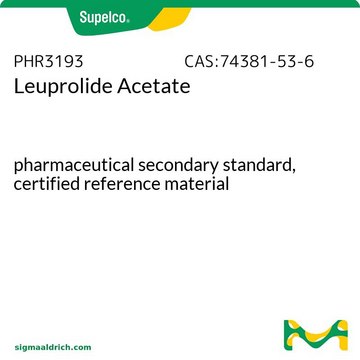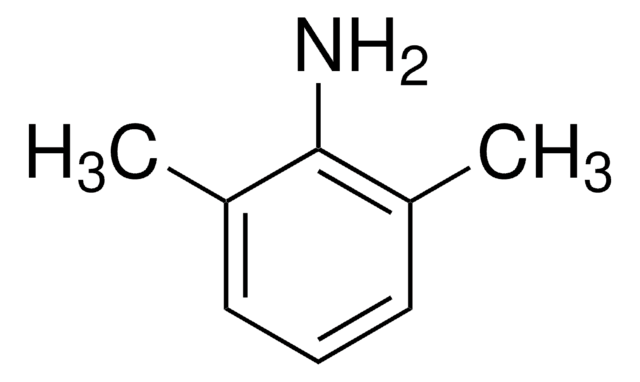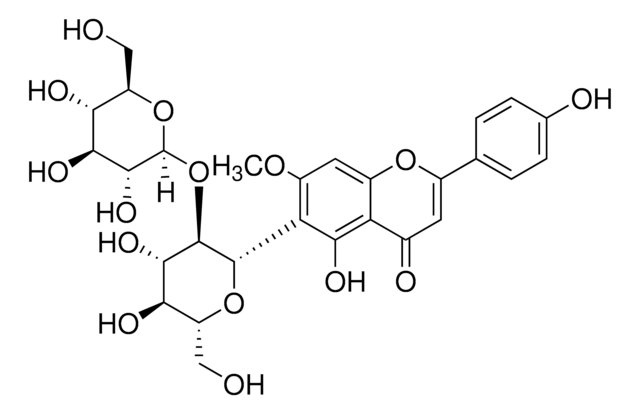SML0241
Ganirelix acetate salt
≥95% (HPLC), lyophilized powder, GnRH antagonist
Synonim(y):
Antagon, N-Acetyl-3-(2-naphthalenyl)-D-alanyl-4-chloro-D-phenylalanyl-3-(3-pyridinyl)-D-alanyl-L-seryl-L-tyrosyl-N6-[bis(ethylamino)methylene]-D-lysyl-L-leucyl-N6-[bis(ethylamino)methylene]-L-lysyl-L-prolyl-D-alaninamide diacetate, Orgalutran
About This Item
Polecane produkty
product name
Ganirelix acetate salt, ≥95% (HPLC)
Próba
≥95% (HPLC)
Postać
lyophilized powder
kolor
white
temp. przechowywania
−20°C
InChI
1S/C80H113ClN18O13.2C2H4O2/c1-9-84-79(85-10-2)88-38-17-15-24-60(70(104)94-62(41-49(5)6)71(105)93-61(25-16-18-39-89-80(86-11-3)87-12-4)78(112)99-40-20-26-68(99)77(111)90-50(7)69(82)103)92-73(107)64(44-53-30-35-59(102)36-31-53)97-76(110)67(48-100)98-75(109)66(46-55-21-19-37-83-47-55)96-74(108)65(43-52-28-33-58(81)34-29-52)95-72(106)63(91-51(8)101)45-54-27-32-56-22-13-14-23-57(56)42-54;2*1-2(3)4/h13-14,19,21-23,27-37,42,47,49-50,60-68,100,102H,9-12,15-18,20,24-26,38-41,43-46,48H2,1-8H3,(H2,82,103)(H,90,111)(H,91,101)(H,92,107)(H,93,105)(H,94,104)(H,95,106)(H,96,108)(H,97,110)(H,98,109)(H2,84,85,88)(H2,86,87,89);2*1H3,(H,3,4)/t50-,60-,61+,62+,63?,64-,65+,66+,67-,68?;;/m1../s1
Klucz InChI
OVBICQMTCPFEBS-HYVLHXRFSA-N
Działania biochem./fizjol.
Hasło ostrzegawcze
Warning
Zwroty wskazujące rodzaj zagrożenia
Zwroty wskazujące środki ostrożności
Klasyfikacja zagrożeń
Eye Irrit. 2 - Skin Irrit. 2 - STOT SE 3
Organy docelowe
Respiratory system
Kod klasy składowania
11 - Combustible Solids
Klasa zagrożenia wodnego (WGK)
WGK 3
Temperatura zapłonu (°F)
Not applicable
Temperatura zapłonu (°C)
Not applicable
Certyfikaty analizy (CoA)
Poszukaj Certyfikaty analizy (CoA), wpisując numer partii/serii produktów. Numery serii i partii można znaleźć na etykiecie produktu po słowach „seria” lub „partia”.
Masz już ten produkt?
Dokumenty związane z niedawno zakupionymi produktami zostały zamieszczone w Bibliotece dokumentów.
Nasz zespół naukowców ma doświadczenie we wszystkich obszarach badań, w tym w naukach przyrodniczych, materiałoznawstwie, syntezie chemicznej, chromatografii, analityce i wielu innych dziedzinach.
Skontaktuj się z zespołem ds. pomocy technicznej








